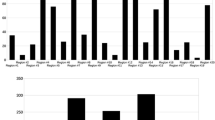Abstract
Optimizing radiologists’ performance is a major priority for managers of health services/systems, since the radiologists’ reporting activity imposes a severe constraint on radiology productivity. Despite that, methods to optimize radiologists’ reporting workplace layout are scarce in the literature. This study was performed in the Radiology Division (RD) of an 850-bed University-based general hospital. The analysis of the reporting workplace layout was carried out using the systematic layout planning (SLP) method, in association with cluster analysis as a complementary tool in early stages of SLP. Radiologists, architects, and hospital managers were the stakeholders consulted for the completion of different stages of the layout planning process. A step-by-step description of the proposed methodology to plan an RD reporting layout is presented. Clusters of radiologists were defined using types of exams reported and their frequency of occurrence as clustering variables. Sectors with high degree of interaction were placed in proximity in the new RD layout, with separation of noisy and quiet areas. Four reporting cells were positioned in the quiet area, grouping radiologists by subspecialty, as follows: cluster 1-abdomen; cluster 2-musculoskeletal; cluster 3-neurological, vascular and head & neck; cluster 4-thoracic and cardiac. The creation of reporting cells has the potential to limit unplanned interruptions and enhance the exchange of knowledge and information within cells, joining radiologists with the same expertise. That should lead to improvements in productivity, allowing managers to more easily monitor radiologists’ performance.





Similar content being viewed by others
References
Bhargavan M, Kaye AH, Forman HP, Sunshine JH: Workload of radiologists in United States in 2006–2007 and trends since 1991–1992. Radiology. 252(2):458–467, 2009. https://doi.org/10.1148/radiol.2522081895
Duszak, Jr R, Muroff LR: Measuring and Managing Radiologist Productivity, Part 1: Clinical Metrics and Benchmarks. Journal of the American College of Radiology. 7(6):452–458, 2010. https://doi.org/10.1016/j.jacr.2010.01.026
MacDonald SL, Cowan IA, Floyd R, Mackintosh S, Graham R, Jenkins E et al.: Measuring and managing radiologist workload: application of lean and constraint theories and production planning principles to planning radiology services in a major tertiary hospital. Journal of medical imaging and radiation oncology. 57(5):544–550, 2013. https://doi.org/10.1111/1754-9485.12090
Ondategui-Parra S, Gill IE, Bhagwat JG, Intrieri LA, Gogate A, Zou KH et al.: Clinical operations management in radiology. Journal of the American College of Radiology : JACR. 1(9):632–640, 2004. https://doi.org/10.1016/j.jacr.2004.04.015
Dora J, Torres F, Gerchman M, Fogliatto F: Development of a local relative value unit to measure radiologists’ computed tomography reporting workload. Journal of medical imaging and radiation oncology, 2016. https://doi.org/10.1111/1754-9485.12492
Crabbe JP, Frank CL, Nye WW: Improving report turnaround time: an integrated method using data from a radiology information system. AJR American journal of roentgenology. 163(6):1503–1507, 1994. https://doi.org/10.2214/ajr.163.6.7992756
Goyal N, Jain N, Rachapalli V: Ergonomics in radiology. Clinical Radiology. 64(2):119–126, 2009. https://doi.org/10.1016/j.crad.2008.08.003
Gupta V. Radiodiagnosis and Imaging Services. In: Goel SD, editor. Textbook of Hospital Administration. 1 ed. India: Elsevier India; 2014.
Tellioğlu H, Wagner I: Work Practices Surrounding PACS: The Politics of Space in Hospitals. Computer Supported Cooperative Work (CSCW). 10(2):163–188, 2001. https://doi.org/10.1023/a:1011298824442
Kulkarni MH, Bhatwadekar SG, Thakur HM: A literature review of facility planning and plant layouts. International Journal of Engineering Sciences & Research Technology. 4(3):35–42, 2015
Shayan E, Chittilappilly A: Genetic algorithm for facilities layout problems based on slicing tree structure. International Journal of Production Research. 42(19):4055–4067, 2004. https://doi.org/10.1080/00207540410001716471
Arnolds I, Nickel S: Layout planning problems in health care. In: Eiselt AH, Marianov V eds. Applications of location analysis. Cham: Springer International Publishing, 2015, p 109–52. https://doi.org/10.1007/978–3–319-20282-2_5
Tompkins JA, White JA, Bozer YA, Tanchoco JMA: Facilities planning. 4 ed: Wiley, 2010
Yang T, Su CT, Hsu YR: Systematic layout planning: a study on semiconductor wafer fabrication facilities. International Journal of Operations & Production Management. 20(11):1359–1371, 2000. https://doi.org/10.1108/01443570010348299
Gupta K, Gupta SK, Kant S, Chandrashekhar R, Satpathy S: Modern trends in planning and designing of hospitals: Principles and practice: Jaypee Brothers Publishers, 2007.
Tortorella GL, Fogliatto FS: Planejamento sistemático de layout com apoio de análise de decisão multicritério. Production. 18:609–624, 2008. https://doi.org/10.1590/S0103-65132008000300015
Muther R: Planejamento do layout: sistema SLP: E. Blucher, 1978
Joseph A, Rashid M: The architecture of safety: hospital design. Current opinion in critical care. 13(6):714–719, 2007. https://doi.org/10.1097/MCC.0b013e3282f1be6e
Suresh NC, Kay JM: Group technology and cellular manufacturing: A State-of-the-Art synthesis of research and practice: Springer US, 2012
Lee Q: Projeto de instalações e do local de trabalho: IMAM, 1998
Muther R, Wheeler JD. Planejamento Sistemático e Simplificado de Layout: Sistema SLP. São Paulo: IMAM; 2000.
Lin Q-L, Liu H-C, Wang D-J, Liu L: Integrating systematic layout planning with fuzzy constraint theory to design and optimize the facility layout for operating theatre in hospitals. Journal of Intelligent Manufacturing. 26(1):87–95, 2015. https://doi.org/10.1007/s10845-013-0764-8
Hua Y, Becker F, Wurmser T, Bliss-Holtz J, Hedges C: Effects of nursing unit spatial layout on nursing team communication patterns, quality of care, and patient safety. Herd. 6(1):8–38, 2012. https://doi.org/10.1177/193758671200600102
Rashid M: Research on nursing unit layouts: an integrative review. Facilities. 33(9/10):631–695, 2015. https://doi.org/10.1108/F-01-2014-0009
Brogmus G, Leone W, Butler L, Hernandez E. Best practices in OR suite layout and equipment choices to reduce slips, trips, and falls. AORN journal. 2007;86(3):384–94; quiz 95-8. https://doi.org/10.1016/j.aorn.2007.06.00
Acknowledgments
This work was made possible by the sponsorship of CNPq (Conselho Nacional de Desenvolvimento Científico e Tecnológico), CAPES (Coordenação de Aperfeiçoamento de Pessoal de Nível Superior), FIPE (Fundação Instituto de Pesquisas Econômicas), and Hospital de Clínicas de Porto Alegre, Brazil.
Author information
Authors and Affiliations
Corresponding author
Ethics declarations
The HCPA’s Ethical Committee has approved this study, and authors have complied with the recommendations of the Declaration of Helsinki.
Rights and permissions
About this article
Cite this article
Benitez, G.B., Fogliatto, F.S., Cardoso, R.B. et al. Systematic Layout Planning of a Radiology Reporting Area to Optimize Radiologists’ Performance. J Digit Imaging 31, 193–200 (2018). https://doi.org/10.1007/s10278-017-0036-9
Published:
Issue Date:
DOI: https://doi.org/10.1007/s10278-017-0036-9




